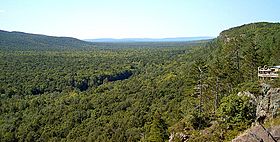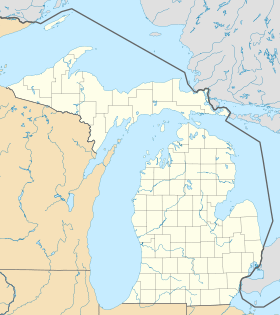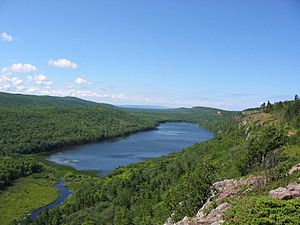Porcupine Mountains facts for kids
Quick facts for kids Porcupine Mountains Wilderness State Park |
|
|---|---|
|
IUCN Category V (Protected Landscape/Seascape)
|
|

A vista in the Porcupine Mountains
|
|
| Location | Ontonagon / Gogebic counties, Michigan, United States |
| Nearest town | Ontonagon, Michigan |
| Area | 59,020 acres (23,880 ha) |
| Elevation | 1,447 feet (441 m) |
| Designation | Michigan state park |
| Established | 1944 |
| Administrator | Michigan Department of Natural Resources |
| Website | Porcupine Mountains Wilderness State Park |
| Designated: | 1984 |
The Porcupine Mountains, also called the Porkies, are a group of small mountains. You can find them in the northwestern part of Michigan's Upper Peninsula. They are located in Ontonagon and Gogebic counties, close to the big Lake Superior.
Native Ojibwe people gave the mountains their name. They thought the mountains looked like a crouching porcupine from a distance. This area is special because it has the largest stand of old-growth (very old, untouched) northern hardwood forest in North America, west of the Adirondack Mountains. This forest covers at least 31,000 acres (12,545 hectares).
Many people love to visit the Porcupine Mountains. Lake of the Clouds, right in the middle of the mountains, is a very popular spot. The whole area is part of the Porcupine Mountains Wilderness State Park.
In the 1800s, people mined copper in the Porcupine Mountains. One famous mine was the Nonesuch Mine. It operated on and off from 1867 to 1912. Because of this history, the state park works with the Keweenaw National Historical Park.
Contents
Mountain Features and Formation
The Porcupine Mountains have a very cool geological feature. It's a long, steep ridge made of basalt and conglomerate rock. This ridge runs along the shore of Lake Superior. It also overlooks the beautiful Lake of the Clouds. This rock is similar to the copper-rich rock found in the Keweenaw Peninsula.
Another ridge is located further inland, past Lake of the Clouds. This ridge includes Summit Peak. Summit Peak is the highest point in the mountains, reaching 1,958 feet (595 meters) high. Between these rocky areas, you'll find rivers, amazing waterfalls, swamps, and lakes. The Presque Isle River on the far western side of the park has many stunning waterfalls.
Weather in the Porkies
The Porcupine Mountains get a lot of lake-effect snow from Lake Superior. This happens because the mountains are high up and very close to the lake. These conditions are perfect for heavy snowfall.
There are no official snow records kept right in the mountains. The closest weather station is in Ontonagon, a town on the coast. There, the average snowfall is about 200 inches (508 cm) each year. It's very likely that the higher parts of the mountains get over 250 inches (635 cm) annually. Some years, they might even get 300 inches (762 cm) of snow!
Plants and Animals of the Park
The Porkies are home to a huge old-growth forest. This means the trees have been growing for a very long time without being cut down. The most common trees you'll see here are sugar maples, American basswood, eastern hemlock, and yellow birch.
Many different animals live in the Porcupine Mountains. You might spot large animals like moose, gray wolves, and white-tailed deer. There are also coyotes, gray and red foxes, and even cougars. Smaller animals include river otters, beaver, fishers, marten, and mink. You might also see bobcats, lynx, black bears, and, of course, porcupines. Many people have reported seeing bears in the park.
Some rare or special animals and plants also live here. These include small blue-eyed mary flowers, ram's head ladyslipper orchids, Hooker's fairy-bells, and slender cliff brake ferns. Rare animals include the wood turtle, peregrine falcon, merlin, and bald eagle.
Porcupine Mountains Wilderness State Park
Porcupine Mountains State Park was created in 1945. Its main goal was to protect the large old-growth forest, especially the "maple-hemlock" type. In 1972, Michigan passed a law called the Wilderness and Natural Areas Act. This law gave the park a new name: Porcupine Mountains Wilderness State Park. This new name shows its special status as a wild, protected area.
The park offers many things for visitors to do. There are lots of backcountry trails for hiking and backpacking. You can stay in rustic cabins along the trails or at modern campgrounds. The park also has places for swimming and boating. Park rangers lead different programs to help you learn about the area. The North Country Trail goes through the park, making up part of the 87 miles (140 km) of hiking trails. In winter, there's even a ski area within the park!




